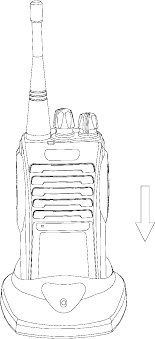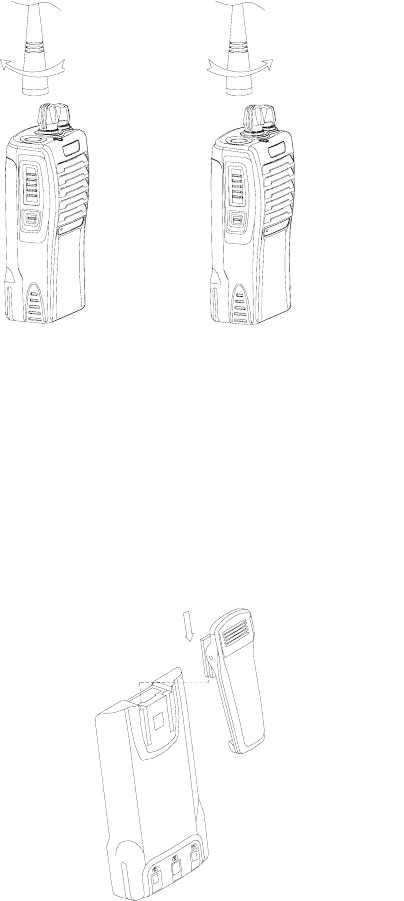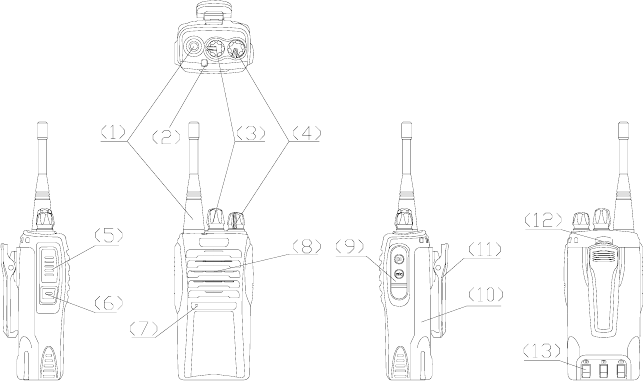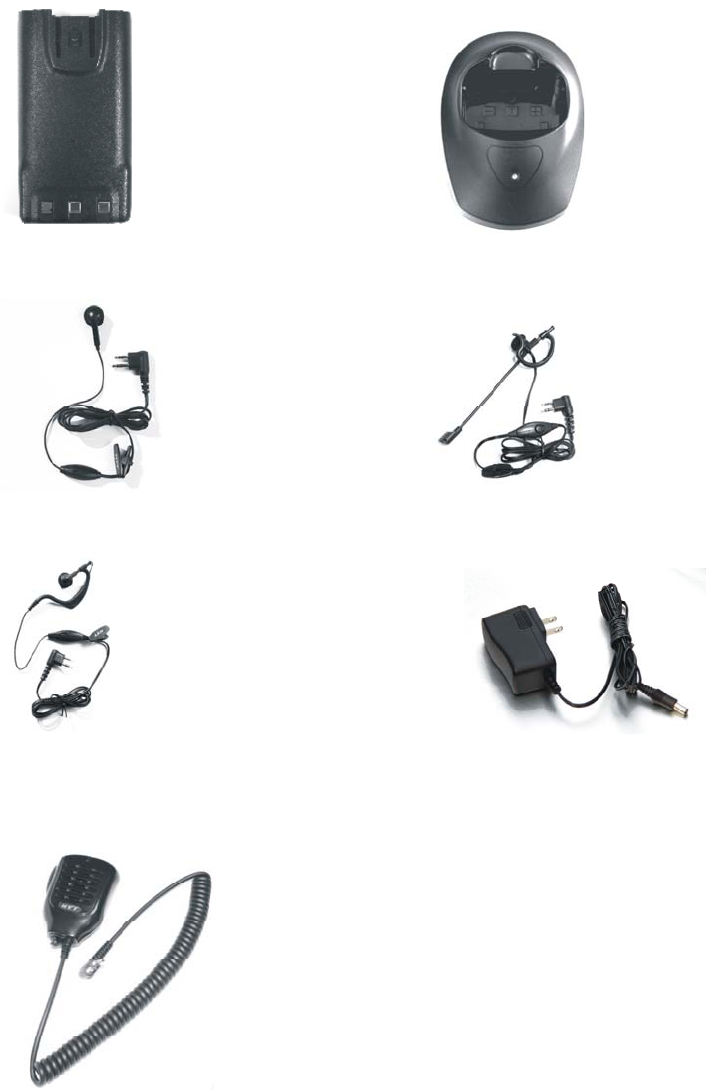HYT Science and Technology Co TC-600U Two Way Radio User Manual TC 600U 2
Shenzhen HYT Science &Technology; Co Ltd Two Way Radio TC 600U 2
Users Manual
1
THANK YOU!
We are grateful for your purchase of HYT product. We believe this easy–to-use radio will
provide you with clear and reliable communications at peak efficiency. This HYT portable
two-way radio is a precision device. Treat it with care, and you will enjoy years of reliable
operation.
MODELS COVERED IN THIS MANUAL
TC-600 UHF Two-way Radio
2
Contents
User Safety, Training, and General Information
Compliance with RF Energy Exposure Standards
FCC Compliance
Precautions
Product Inspection
Battery Information
Accessory Installation
Radio Overview
Features and Operation
Basic Operations
Time-Out-Timer (TOT)
Battery Save
Low Battery Alert
Monitor
Programmable Function Key
High/Low Power
Compatible Channel Bandwidth
2-Tone Encode & Decode
DTMF ANI
CTCSS/DCS Signalling
Signalling AND/OR Logic
Channel Scan
Busy Channel Lockout
Troubleshooting Guide
Care and Cleaning
Optional Accessories
Frequency Chart
3
User Safety, Training, and General Information
READ THIS IMPORTANT INFORMATION ON SAFE AND EFFICIENT OPERATION
BEFORE USING YOUR HYT PORTABLE TWO-WAY RADIO.
Compliance with RF Energy Exposure Standards
Your HYT two-way radio is designed and tested to comply with a number of national and
international standards and guidelines (listed below) regarding human exposure to radio
frequency electromagnetic energy. This radio complies with the IEEE (FCC) and ICNIRP
exposure limits for occupational/controlled RF exposure environment at duty cycles of up
to 50% talk-50% listen and should be used for occupational use only. In terms of
measuring RF energy for compliance with the FCC exposure guidelines, your radio
radiates measurable RF energy only while it is transmitting (during talking), not when it is
receiving (listening) or in standby mode.
Note: The approved batteries supplied with this radio are rated for a 5-5-90 duty cycle (5%
talk-5% listen-90% standby), even though this radio complies with the FCC
occupational RF exposure limits at duty cycles of up to 50% talk.
Your HYT two-way radio complies with the following of RF energy
exposure standards and guidelines:
United States Federal Communications Commission, Code of Federal Regulations;
47CFR part 2 sub-part J
American National Standards Institute (ANSI)/Institute of Electrical and Electronic
Engineers (IEEE) C95. 1-1992
Institute of Electrical and Electronic Engineers (IEEE) C95. 1-1999 Edition
International Commission on Non-Ionizing Radiation Protection (ICNIRP) 1998
Operational Instructions and Training Guidelines
To ensure optimal performance and compliance with the occupational/controlled
environment RF energy exposure limits in the above standards and guidelines, users
should transmit no more than 50% of the time and always adhere to the following
procedures:
Transmit and Receive
To transmit (talk), push the Push-To-Talk (PTT) button; to receive, release the PTT button.
Hand-held radio operation
Hold the radio in a vertical position with the microphone one to two inches (2.5 to 5 cm)
away from the lips.
Body-worn operation
Always place the radio in an HYT approved clip, holder, holster, case, or body
harness for this product. Use of non-HYT-approved accessories may exceed FCC
RF exposure guidelines.
4
Antennas & Batteries
Use only HYT approved, supplied antenna or HYT approved replacement antenna.
Unauthorized antennas, modifications, or attachments could damage the radio and
may violate FCC regulations.
Use only HYT approved, supplied batteries or HYT approved replacement batteries.
Use of non- HYT -approved batteries may exceed FCC RF exposure guidelines.
Approved Accessories
For a list of HYT approved accessories, see the accessories page of this user manual or
visit the following website which lists approved accessories: http://www.HYT.com.cn
FCC Compliance
This equipment has been tested and found to comply with the limits for a Class B digital
device, pursuant to part 15 of the FCC Rules. These limits are designed to provide
reasonable protection against harmful interference in a residential installation. This
equipment generates, uses and can radiate radio frequency energy and, if not installed
and used in accordance with the instructions, may cause harmful interference to radio
communications. However, there is no guarantee that interference will not occur in a
particular installation. If this equipment does cause harmful interference to radio or
television reception, which can be determined by turning the equipment off and on, the
user is encouraged to try to correct the interference by one or more of the following
measures:
Reorient or relocate the receiving antenna.
Increase the separation between the equipment and receiver.
Connect the equipment into an outlet on a circuit different from that to which the
receiver is connected.
Consult the dealer or an experienced radio/TV technician for help.
FCC Requirements
Your radio must be properly licensed Federal Communications Commission prior to use.
Your HYT Wireless dealer can assist you in meeting these requirements. Your dealer will
program each radio with your authorized frequencies, signaling codes, etc., and will be
there to meet your communications needs as your system expands.
5
Precautions
• Only qualified technicians are allowed to maintain this product.
• Do not use the radio or charge a battery in explosive areas such as coal gas, dust,
steam, etc.
• Switch OFF the radio while refueling or parking at gas station.
• Do not modify or adjust this radio without permission.
• Do not expose the radio to direct sunlight over a long time, nor place it close to heating
source.
• Do not place the radio in excessively dusty, humid areas, nor on unstable surfaces.
Safety: It is important that the operator is aware of and understands hazards common to
the operation of any radio.

6
Product Inspection
Please carefully unpack the radio. Before use, it is recommended that you inspect the
product as follows.
First check the shipping carton for any signs of damage. Confirm the supplied product
against the packing slip to assure accuracy. If any items are missing or have been
damaged during shipment, please contact your dealer immediately.
Supplied Accessories
*Note:
Frequency is marked on the color circle of the antenna. Red circle indicates UHF. If
frequency is not marked on the color circle, please refer to the label on the main unit for
details.
Item Qty. (pcs)
Antenna * 1
Charger 1
Switch Power 1
Li-ion Battery Pack 1
Belt Clip 1
Strap 1
Owner’s Manual 1

7
Battery Information
Battery Charging Information
The battery is not charged at the factory. Batteries must be fully charged before initial use
or if they have not been used for some period of time.
The battery capacity will be optimum only after being charged / discharged for two or three
times. When the battery power is low, it either needs to be charged or replaced with a new
one.
Notices:
Do not short the battery terminals or dispose of the battery by fire.
Turn off the radio when charging the attached battery.
Remove the radio and the battery from the charger when charging cycle is over. Do
not recharge the battery if it is already fully charged. Overcharging will shorten the
battery life.
Store the battery in a place about room temperature (25℃). Charging the battery in
temperatures less than 10℃ may cause electrolyte leakage and damage the battery.
Charging the battery in temperatures greater than 35℃ will affect the battery capacity.
Battery Charging
Insert the battery or the radio with battery into the charger, and make sure that the battery
connectors are in contact with the charging terminals. The LED glows red during charging
and green when battery is fully charged.

8
Accessory Installation
Attaching the Battery
1. Turn off the radio.
2. Insert the tabs at the bottom of the battery into the slots at the bottom of the radio
chassis.
3. Press the top of the battery towards the radio until a “click” is heard. (See Figure 1)
①
②
(Fig. 1)
Removing the Battery
1. Turn off the radio.
2. Push the battery latch on the back panel towards the top of the radio.
3. Pull the top of the battery away from the radio chassis, and lift the battery from the radio.
(See Figure 2)
①
②
③
(Fig. 2)
Attaching the Antenna
1. Align the threaded end of the antenna with the radio’s antenna connector.

9
2. Turn the antenna clockwise to tighten. (See Figure 3)
Removing the Antenna
1.Turn the antenna counterclockwise until you can remove it. (See Figure 3)
拆卸安装
(Fig. 3)
Attaching the Belt Clip
1. Align the grooves of the belt clip with those of the battery.
2. Press the belt clip downwards until the belt clip tab locks. (See Figure 4)
Note: attach the belt clip before installing the battery.
①
(Fig. 4)
Removing the Belt Clip
1. Press the belt clip tab upwards until it releases.
2. Slide the belt clip upwards to remove it. (See Figure 5)
Note: remove the battery pack prior to removing the belt clip.
A
ttach Remove

10
①
②
③
(Fig. 5)
Attaching External Earphone (Optional)
1. Remove the cover of earphone jack.
2. Rotate the cover until earphone jack comes into view.
3. Insert the earphone plug into the jack.

11
Radio Overview
(1) Antenna
Used to transmit/receive signals.
(2) LED Indicator
The radio LED glows red during transmission and green during reception; The LED
flashes red when battery voltage is low.
(3) Channel Selector Knob
(4) Power/Volume Control Knob
Rotate the knob clockwise until a “click” is heard to turn the radio on, fully counter
clockwise until a “click” is heard to turn the radio off. When the radio is on, turn the
knob to adjust volume.
(5) PTT Key
Hold down the [PTT] key to transmit, release it to receive.
(6) Function Key
The key can be programmed to access the radio features with the preset type of key
pressing through the programming software.
(7) Microphone
Used to input sounds.
(8) Speaker
Used to output sounds.
12
(9) External Jack (for external earphone or radio programming)
Rotate the jack cover and insert accessory plug or insert programming cable into the
jack to program the radio via programming software.
(10) Battery
(11) Belt Clip
Used to clip radio on your belt.
(12) Battery Latch
Used to fasten and remove the battery.
(13) Charging Connector
Insert the battery into the charger; connect the charging connectors with those on the
charger to begin charging.
13
Features and Operation
Basic Operations
1. Turn on the radio: Turn the Power/Volume Control Knob clockwise until a “click” is
heard.
2. Adjust the volume: Turn the Power/Volume Control Knob to adjust the volume. When
function key is programmed with monitor feature, turn the knob while holding down the
function key to adjust the volume to a comfortable level.
3. Select a Channel: Rotate Channel Selector knob to select your desired channel.
4. Transmit: Hold down the [PTT] key, speak into the microphone with normal voice.
Keep microphone about 5cm away from your mouth.
5. Receive: Release the [PTT] key, the radio returns to receive mode.
Note: when battery voltage becomes too low, transmission will stop and radio LED flashes
red. Please refer to “Low Battery Alert” for more details.
Time-Out-Timer (TOT)
The Time-Out-Timer (TOT) is used to prevent someone from using the same channel for
a long time and to prevent the radio from damage due to continuous transmission.
If the transmission exceeds the preset time (it’s set by your dealer), transmission will be
inhibited and a beep tone will sound. To stop the beep tone, release the [PTT] key. Press
the [PTT] key again to resume transmitting.
■ TOT Reset Time
When this feature is activated, TOT won’t reset until the preset TOT Reset Time (it’s set by
your dealer) expires, even if you have released the [PTT] key.
■
TOT Rekey Time
TOT Rekey Time is the duration that transmission is resumed after being inhibited by TOT.
When this feature is activated, transmission will remain inhibited until the preset TOT
Rekey Time (it’s set by your dealer) expires, even if you have pressed the [PTT] key.
14
■ TOT Pre-Alert
Your dealer can program a TOT Pre-Alert feature to alert you just before the TOT expires.
When this feature is activated, the radio will sound an alert tone at the preset TOT
Pre-Alert time (1-255s before the TOT expires). Transmission will be inhibited by TOT
after this time.
Battery Save
The Battery Save feature is enabled by your dealer to minimize the power consumption.
When there is no activity on the channel and no operation is performed for 10 seconds,
the Battery Save feature is automatically activated. When a signal is received or an
operation is performed, the Battery Save feature is automatically deactivated.
Low Battery Alert
Low Battery Alert alerts you to recharge or replace the battery. During transmission, when
the battery voltage goes below a preset value, the LED indicator will flash red. When the
alert tone sounds, the radio stops transmitting. Please recharge or replace the battery.
Monitor
This feature is enabled/disabled by your dealer. In receive mode, press the
preprogrammed MONI key to monitor activities on the current channel. This operation is
especially useful for adjusting volume level or receiving a weak signal. The LED indicator
glows green in monitor mode.
Programmable Function Key
This key can be programmed as a shortcut to Monitor or High/Low Power feature, or set
inactive through the programming software. 3 types of key pressing can be defined:
● Short Press—quickly press and release the key within 1 second
● Long Press—press and hold the key for more than 1 second
● Press—press the key in any manner
15
High/Low Power
This feature is enabled/disabled by your dealer. In receive mode, press the
preprogrammed High/Low Power key to toggle between high and low power. Three beeps
alternating from high tone to low tone indicate that the transmit power is switched from
high to low; and three beeps alternating from low tone to high tone indicate that the
transmit power is switched from low to high.
Compatible Channel Bandwidth
The dealer can select wideband or narrowband channel bandwidth via PC programming
software.
2-Tone Encode & Decode
When 2-Tone signalling is set, press the function key while holding down the [PTT] key to
transmit the 2-Tone code. 2-Tone decode and CTCSS/DCS decode can be set to one of
the two signalling logics (“AND”/ “OR”) to achieve Selective Call feature (set by your
dealer). Parameter settings are made through PC programming software.
DTMF ANI
This feature is enabled/disabled by your dealer. DTMF ANI is encoded by PTT ID. Each
radio is assigned with one ANI code consisting of BOT ID (Beginning of Transmission) and
EOT ID (End of Transmission). Each channel can be programmed by PC programming
software to transmit/not transmit ANI code in transmit mode.
CTCSS/DCS Signalling
CTCSS/DCS may have been programmed on a channel to ignore unwanted calls from
other parties on the same channel. When CTCSS/DCS signaling is set, user will receive
the calls on the same channel only when the received signals contain the matching
CTCSS/DCS code; otherwise, the user receives all the calls on the same channel within
communication range.
16
The dealer can preset CTCSS/DCS signalling on all or just certain channels.
Note: Although using CTCSS/DCS enables you to avoid hearing unwanted calls, it does
not mean your calls will be private.
Signalling AND/OR Logic
Signalling "AND"/"OR" sets the audio unmute condition for any channel programmed with
2-Tone or CTCSS/DCS.
2-Tone AND CTCSS/DCS:
The squelch opens only when both 2-Tone and CTCSS/DCS are received and matches
the preset one on selected channel.
2-Tone OR CTCSS/DCS:
The squelch opens when either 2-Tone or CTCSS/DCS is received and matches the
preset one on selected channel.
Channel Scan
■ Priority Channel Scan
Any programmed channel may be set as the priority channel. The radio will check the
priority channel periodically while stopping on a non-priority channel. When there is any
activity on the priority channel, the radio will automatically switch to the priority channel for
communications.
■ Scan Revert Channel
If the radio is scanning and you press the [PTT] key, it will transmit on the preprogrammed
revert channel. The revert channel can be programmed by your dealer.
Busy Channel Lockout
If the Busy Channel Lockout feature is enabled by your dealer, it will prevent you from
talking on a channel that is already in use. When you press the [PTT] key, the radio will
sound a beep tone and will not transmit. Release the [PTT] key to stop the beep tone.
Wait until the channel is not in use before you again try to transmit.

17
Troubleshooting Guide
Trouble Solution
No power ●Battery is low. Recharge or replace the battery.
●The battery may not be properly installed. Remove
the battery and attach it again.
Power doesn't last long even if
fully charged
●Battery has lost its capacity, replace it with a new
one.
Can't talk to or hear group
members
●Make sure you are using the same frequency, same
CTCSS/DCS and same 2-Tone as your group
members.
●Your group members may be out of the
communication range.
Other voice (non-group
members) are present on the
channel
●Change CTCSS/DCS tone. Make sure your group
members all change to the same tone.
Care and Cleaning
◇ Do not carry your radio by the antenna or remote microphone;
◇ Wipe the battery contacts with a lint-free cloth to remove dirt, grease, or other
material that may prevent good electrical connection;
◇ When not in use, keep the accessory jacks covered with the protective caps;
◇ Clean the shell, controls and keys of your radio with neutral detergent and warm
water after a long period of usage. Avoid using strong chemicals.

18
Optional Accessories
Ni-MH Battery BH-T600A Regular Charger (Ni-MH)
Earbud Style Ear Microphone ES-M1 Earholder Style Ear Microphone (with tube) EH-M2
Earholder Style Ear Microphone EH-M3 Switching Power Supply
Remote Speaker Microphone SM-06M01

19
Frequency Chart
Model:
Serial Number:
Channel Transmit
Frequency
Transmit
CTCSS/DCS
Receive
Frequency
Receive
CTCSS/DCS
1
2
3
4
5
6
7
8
9
10
11
12
13
14
15
16
HYT endeavors to achieve the accuracy and completeness of this manual.
All the above specifications and design are subject to change by HYT without notice.
All the reproduction and translation of this manual without authorization of HYT is not
allowed.